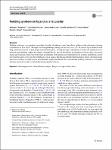| dc.contributor.author | Pollanen, Michael S. | |
| dc.contributor.author | Onzivua, Sylvester | |
| dc.contributor.author | Robertson, Janice | |
| dc.contributor.author | McKeever, Paul M. | |
| dc.contributor.author | Olwa, Francis | |
| dc.contributor.author | Kitara, David L. | |
| dc.contributor.author | Fong, Amanda | |
| dc.date.accessioned | 2023-06-26T13:18:19Z | |
| dc.date.available | 2023-06-26T13:18:19Z | |
| dc.date.issued | 2018 | |
| dc.identifier.citation | Pollanen, M. S., Onzivua, S., Robertson, J., McKeever, P. M., Olawa, F., Kitara, D. L., & Fong, A. (2018). Nodding syndrome in Uganda is a tauopathy. Acta neuropathologica, 136, 691-697. | en_US |
| dc.identifier.uri | http://ir.lirauni.ac.ug/xmlui/handle/123456789/719 | |
| dc.description.abstract | Nodding syndrome is an epidemic neurologic disorder of unknown cause that affects children in the subsistence-farming
communities of East Africa. We report the neuropathologic findings in five fatal cases (13–18 years of age at death) of nodding
syndrome from the Acholi people in northern Uganda. Neuropathologic examination revealed tau-immunoreactive
neuronal neurofibrillary tangles, pre-tangles, neuropil threads, and dot-like lesions involving the cerebral cortex, subcortical
nuclei and brainstem. There was preferential involvement of the frontal and temporal lobes in a patchy distribution, mostly
involving the crests of gyri and the superficial cortical lamina. The mesencephalopontine tegmental nuclei, substantia nigra,
and locus coeruleus revealed globose neurofibrillary tangles and threads. We conclude that nodding syndrome is a tauopathy
and may represent a newly recognized neurodegenerative disease. | en_US |
| dc.language.iso | en | en_US |
| dc.publisher | Acta neuropathologica | en_US |
| dc.subject | Neurodegeneration | en_US |
| dc.subject | Neurofibrillary tangles | en_US |
| dc.subject | Progressive supranuclear palsy | en_US |
| dc.title | Nodding syndrome in Uganda is a tauopathy | en_US |
| dc.type | Article | en_US |

